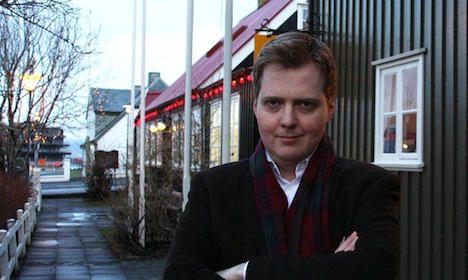Kim Jong-un, at age 30, is the world’s youngest leader, and there are only a handful of thirtysomething world leaders.![]()
But if polls are correct, Sigmundur Davíð Gunnlaugsson (pictured above) may lead Iceland’s Framsóknarflokkurinn (Progressive Party) to victory in April 27’s parliamentary elections, giving the Progressives their best victory since 1931 and, perhaps, in its history. That would make Gunnlaugsson, at age 37, the country’s youngest prime minister since its 1944 independence.
Icelandic voters go to the polls Saturday after a fairly tumultuous time over the past five years following the 2008 collapse of its banking sector, a massive depreciation and the introduction of capital controls on Iceland’s currency, the krónur, despite a return to tepid GDP growth after a 6.5% contraction in 2009 and an unemployment rate that’s now below 5%.
I’ll sideswipe the long debate among American economists over whether Iceland’s economic policy was smarter than that in Ireland or the Baltic states. If you want an in-depth take from an Icelandic observer, read this instead. I’ll add that Iceland’s ability to set its own monetary policy certainly helped it bounce back in terms of GDP growth, but it also glided the path for a massive krónur depreciation and inflation that’s eroded those gains that Iceland has made in the past five years. Much of Iceland’s household debt, before 2008, was denominated in non-krónur currencies, and debt today is otherwise linked to currency or inflation indices. That has made debt repayment, especially for home mortgages, a grueling nightmare in post-boom Iceland.
So the economic situation is Iceland is complicated, and though there’s a lot of evidence to suggest that Iceland’s economy might even be worse if it were part of the eurozone, that doesn’t mean that the everyday Icelandic voter feels like things are quite back to normal.
But politics, however, do seem set to return to the pre-boom ‘normal,’ given that the Progressives were a longtime ally of the dominant party in Iceland’s history since independence, the Sjálfstæðisflokkurinn (Independence Party), which was formed precisely — as you may have guessed — to enact Icelandic independence from Denmark.
The two parties are now fighting for first place in the April 27 parliamentary elections, and it’s virtually certain that they’ll form the coalition that constitutes Iceland’s next government. No party in Iceland’s post-independence history has even won an absolute majority in the 63-member Alþingi, Iceland’s parliament.
Polls have shown the Progressive Party with a growing lead throughout 2013, stemming largely from their insistence that Iceland should not reimburse the U.K. and other governments for the Icesave debacle — non-Icelandic savers who had deposited their money in Icesave were wiped out in late 2008, and though their own government have largely made them whole, they have turned to Iceland for repayment with interest. Although most Icelandic parties agree that Iceland should make the payment, the matter’s been tangled up in both domestic and international litigation, and the repayments are very, very unpopular among the Icelandic electorate.
But the Independence Party seems to be catching up once again, and the two parties are now essentially tied for the lead, meaning that either party could win the greatest number of seats in the Alþingi. If the Independence Party does edge out the Progressives, Iceland’s new prime minister could be the Independence Party leader, Bjarni Benediktsson (pictured below), who only narrowly survived a leadership challenge a couple of weeks ago, when the party’s polling numbers were more depressed.

That would augur a remarkable return to power for two parties that, prior to 2009, dominated Icelandic governance. Except for two short periods, each less than a year, at the end of the 1950s and the end of the 1970s, the two parties held the prime minister’s office continuously from 1949 until their historical defeat in 2009.
The Independence Party’s Geir Haarde served as prime minister from 2006 to 2009, the Progressive Party’s Halldór Ásgrímsson preceded him from 2004 to 2006, and the Independence Party’s Davíð Oddsson served as prime minister from 1991 to 2004 (and thereafter, from 2005 to 2009 as Iceland’s central bank president). Despite the unpopularity of Haarde and Oddsson today — their libertarian center-right policy is widely blamed for establishing the conditions that led to the 2008 financial and banking crisis — voters seem willing to entrust Iceland’s future to their political heirs, Benediktsson and Gunnlaugsson.
The Samfylkingin (Social Democratic Alliance), the party of current prime minister Jóhanna Sigurðardóttir, won the largest share of the vote in the April 2009 election with 29.8% and 20 seats, though it and its current coalition partner, the Vinstrihreyfingin – grænt framboð (Left-Green Movement) are each set to lose about half of their 2009 support, according to polls. Sigurðardóttir, who has been a member of the Alþingi since 1978, and is the world’s only openly gay head of government, indicated last year that she would not stand for another term.
It’s an all-too-familiar pattern in post-crisis Europe — the center-right, having been in power during the onset of the crisis, have been rejected in favor of the center-left, who have also become unpopular in the face of their own helplessness to solve a regional economic problem and are thereafter booted in favor of a return to power of the center-right. It’s happened in Greece, it may be happening in France, and it seems like it’s happening in reverse in Spain and the United Kingdom (where the crisis happened on the left’s watch, and now the right is struggling to cope with sputtering economies).
At issue is not only the future direction of Icelandic economic policy and Iceland’s relationship with the European Union, but also the future of its new, much heralded ‘crowd sourced’ constitution, which the current government supports, though the Independence Party has opposed it and the referendum over the constitution held last October.
Both the Progressive and Independence parties want to remove the currency controls on the Icelandic currency in order to attract more foreign investment — the currency controls, among other reasons, are one of the factors that are harming the Social Democratic Alliance, which favors joining the European Union and, virtually alone among Iceland’s parties, would join the eurozone as well.
But one of the reasons for the Social Democratic Alliance’s collapse is the emergence of two new parties, each of which could win between 5% and 10% of Saturday’s vote. The first is Björt framtíð (Bright Future), a pro-Europe, liberal party founded in February 2012 by former Social Democrats and Progressives. The Píratar (Pirate Party of Iceland) is even newer, founded only in November 2012, and it’s drawing support as well, though its political program, like that of the German Pirate Party, remains relatively vague.

One thought on “Center-right parties poised to return to power in Iceland”